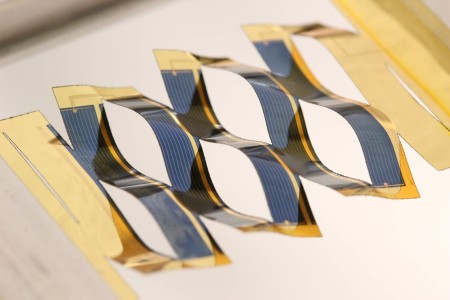Sep
10
New Lightweight Solar Cells Can Track the Sun
September 10, 2015 | 5 Comments
Solar cells capture up to 40 percent more energy when they can track the sun across the sky, but conventional, motorized trackers are too heavy and bulky for pitched home rooftops and vehicle surfaces.
Residential rooftops make up about 85 percent of solar panel installations in the U.S., according to a report from the Department of Energy, but these roofs would need significant reinforcing to support the weight of conventional sun-tracking systems.
Aaron Lamoureux, a doctoral student in materials science and engineering and first author on the paper in Nature Communications (available without a paywall) said, “The design takes what a large tracking solar panel does and condenses it into something that is essentially flat.”
A team of UM engineers and an artist developed an array of small solar cells that can tilt within a larger panel, keeping their surfaces more perpendicular to the sun’s rays.

Kirigami Inspired Lightweight Solar Cells Track the Sun. A flat plastic sheet backing the solar cells splits into wavy, connected ribbons when stretched. The tilt of the cells depends on the stretching, a simple mechanism for tracking the sun across the sky. Image Credit: Aaron Lamoureux, University of Michigan. Click image for the largest view.
Max Shtein, associate professor of materials science and engineering said, “The beauty of our design is, from the standpoint of the person who’s putting this panel up, nothing would really change. But inside, it would be doing something remarkable on a tiny scale: the solar cell would split into tiny segments that would follow the position of the sun in unison.”
Solar cell researchers think of tracking in terms of how much of a solar panel the sun can “see.” When the panel is at an angle, it looks smaller. By designing an array that tilts and spreads apart when the sun’s rays are coming in at lower angles, they raise the effective area that is soaking up sunlight.
To explore patterns, the team of engineers worked with paper artist Matthew Shlian, a lecturer in the U-M School of Art and Design. Shlian showed Lamoureux and Shtein how to create them in paper using a plotter cutter. Lamoureux then made more precise patterns in Kapton, a space-grade plastic, using a carbon-dioxide laser.
Although the team tried more complex designs, the simplest pattern worked best. With cuts like rows of dashes, the plastic pulled apart into a basic mesh. The interconnected strips of Kapton tilt in proportion to how much the mesh is stretched, to an accuracy of about one degree.
To make the solar array, Kyusang Lee, a doctoral student in electrical engineering, built custom solar cells in the lab of Stephen Forrest, the Peter A. Franken Distinguished University Professor of Engineering and Paul G. Goebel Professor of Engineering. He and Lamoureux attached them to an uncut piece of Kapton, leaving spaces for the cuts. Then, Lamoureux patterned the Kapton with the laser cutter.
The design with the very best solar-tracking promise was impossible to make at UM because the solar cells would be very long and narrow. Scaling up to a feasible width, the cells became too long to fit into the chambers used to make the prototypes on campus, so the team is looking into other options.
The optimized design is effective because it stretches easily, allowing a lot of tilt without losing much width. According to the team’s simulations of solar power generation during the summer solstice in Arizona, it is almost as good as a conventional single-axis tracker, offering a 36 percent improvement over a stationary panel. Conventional trackers produce about 40 percent more energy than stationary panels under the same conditions, but they are bulky, prone to catching the wind and ten or more times heavier, Shtein said.
“We think it has significant potential, and we’re actively pursuing realistic applications,” Shtein said. “It could ultimately reduce the cost of solar electricity.”
This one of the best examples of cross expertise application. Whoever had the idea to look into kirigami and invite in an expert artist has one of the most intuitive minds in memory.
A 36 percent improvement is huge and the congratulations are just as huge as well!
Comments
5 Comments so far


This is ingenious, and it should be quite cost effective to implement.
This would be excellent for those of us that live at higher latitudes (and high winds!) Is there any estimate as to when these would be commercially available?
This is a very nice idea and implementation. Small elements lead to less glass, metal, etc…, hence reduced costs and better wind resistance.
I would not want anything bearing electricity in or on my house using Kapton. Over time the Kapton breaks down, outgasses and the left over residue forms a carbolic crystal. If an electric current is flowing through the wire that is insulated by the kapton and a drop of water gets on it, the insulation goes into spontaneous combustion for the whole length of the wire. This has readily been shown in many experiments. In the Navy and Air Force we have removed this wiring from our aircraft.
Since the Silicon wafer based solar cells are prone to micro-cracks even during the fluttering during wind inside the fixed frame solar panels; how would the issue be addressed considering minimum 365X2 Twists in a year and 730X30 = 21900 twists & turns throughout the life cycle of 30 years of the solar panel?